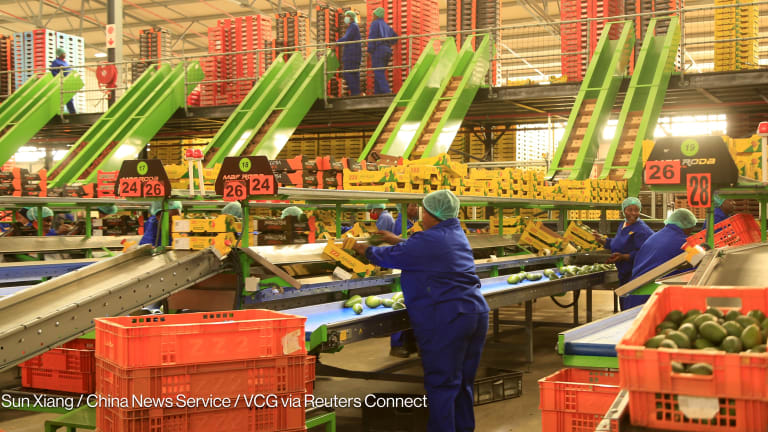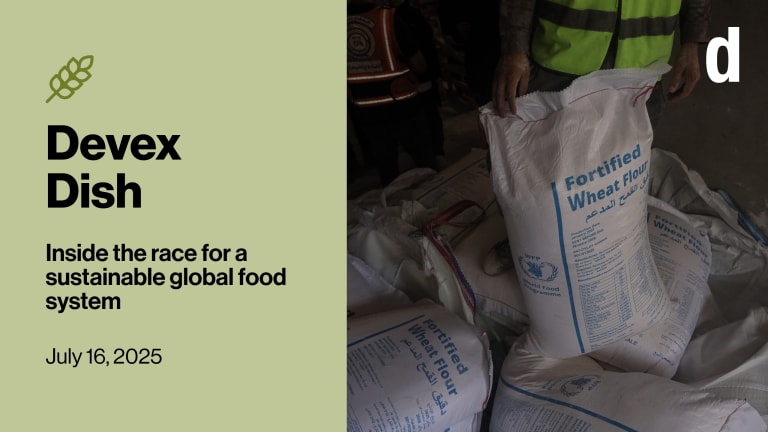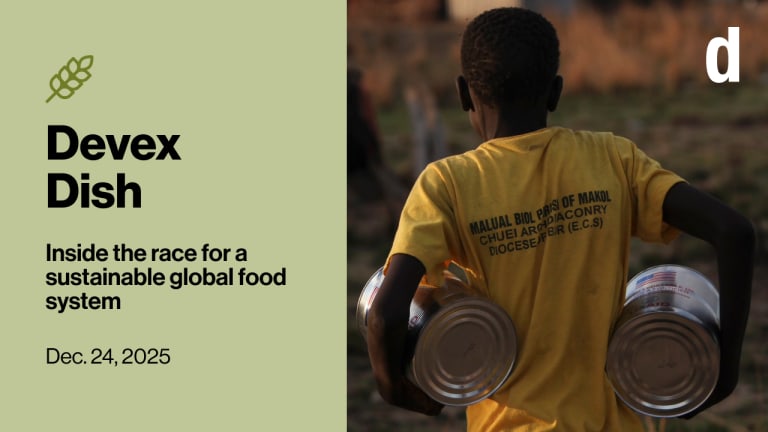4 years on, Feed the Future at a turning point
Feed the Future has made headway in reorienting Washington’s approach to food security toward agricultural development. Whether or not the Obama administration’s most high-profile development initiative realizes its full potential will likely hinge on these five key questions.
In 2009, U.S. President Barack Obama unveiled the administration’s multibillion dollar global hunger and food security initiative called Feed the Future. Prompted in large part by the global food price crisis in 2008, Feed the Future aims to reorient the U.S. government approach to food security toward targeted, coordinated and country-driven investments in agricultural development that can help reduce poverty in the longer-term. It also aims to shift America’s traditional approach to food security away from delivering emergency food aid by promoting self-sufficiency. According to the administration, the initiative — which is led by the U.S. Agency for International Development — focuses on six key areas: inclusive agriculture sector growth, gender integration, improved nutrition, private sector engagement, research and capacity building, and climate-smart development. Despite some early skepticism, many in the global development community consider Feed the Future the administration’s single most transformative aid initiative to date and some reputable third parties say that Feed the Future’s emphasis on agricultural development is beginning to prove to be an effective poverty reduction strategy. According to both the ONE campaign and the One Acre Fund, Feed the Future programs have “undoubtedly played an important role” in markedly reducing poverty in the initiative’s 19 focus countries. In contrast to the U.S. Global Health Initiative, which has by many accounts fallen short on its promise to synergize the U.S. global health regime, Feed the Future appears to have made headway in its efforts to better coordinate U.S. food security programs. A recent report from the U.S. Government Accountability Office found that Feed the Future had made “good progress” in applying a whole-of-government approach to food security. Echoing other independent evaluations, the GAO report also confirmed that USAID has been actively coordinating and engaging with country stakeholders in its Feed the Future programming, in line with the initiative’s commitment to country-led development. Despite these positive assessments, administration officials and aid groups alike emphasize that agricultural development is a long-term process. According to some estimates, it could take another decade of sustained investment from Feed the Future before the initiative produces a durable impact on the ground. Whether or not the initiative realizes its full potential in the coming years will likely hinge on these key questions surrounding the future of Feed the Future. Will Republicans go after Feed the Future’s budget once more? When he first unveiled Feed the Future in 2009, Obama pledged $3.5 billion toward the initiative over the next three years. Drawing only limited scrutiny from congressional Republicans, the administration would eventually exceed this commitment by more than $350 million — no small accomplishment amid budget pressures in Washington. In the run-up to last year’s presidential election, however, congressional Republicans came out swinging against Feed the Future. Just weeks before being named the Republican nominee for vice president, House Budget Chairman Paul Ryancalled for the elimination of Feed the Future in his fiscal 2013 budget proposal. Ryan’s fiscal 2014 budget proposal has quietly removed any references to defunding Feed the Future. Since the beginning of his second term, Obama has refrained from setting another multiyear funding target for Feed the Future. Nonetheless, for fiscal 2014, the president has requested $1.1 billion for the initiative, which is roughly comparable to its budget in previous years. The fate of the president’s Feed the Future budget requests in fiscal 2014 and beyond will depend in large part on whether Republicans — who will control the House until at least next year — see a worthwhile debate surrounding Feed the Future and revive their challenge. Will civil society have a seat at the table too? Among the administration’s three marquee aid initiatives — the others being the Global Health Initiative and the Global Climate Change Initiative — Feed the Future stands out for its success at tapping private sector partners in support of its strategy and programming. In 2010, USAID Administrator Rajiv Shah unveiled the initiative’s public-private partnership hub and in the years since, Feed the Future has forged hundreds of PPPs, including withPepsiCo,General Mills,Cargill and Wal-Mart. Shah recently announced plans to channel a quarter of Feed the Future funding in fiscal 2014 to public-private partnerships under the New Alliance for Food Security and Nutrition, which Obama launched last year. On the other hand, some observers assert that Feed the Future’s efforts to engage civil society have missed the mark. Late last year, the humanitarian organization Catholic Relief Services (which works in the majority of Feed the Future priority countries) testified before the U.S. Senate that the initiative’s programs did not regularly solicit input from either U.S.-based or local nongovernmental organizations. In a bid to allay these concerns, Shah announced the formation of a working group tasked with developing an action plan for enhancing Feed the Future’s collaboration with civil society. Will USAID have enough staff to carry Feed the Future forward? In the early days of Feed the Future, administration officials conceded that the sharp decline in USAID’s in-house staff over the years had left USAID without the requisite personnel to develop and administer the initiative’s programming. Between 1999 and 2009, the number of agricultural officers at the agency had dropped from 47 to 22. Since then, USAID, through its reform agenda, has committed to rebuild the agency’s capacity and set a goal of hiring 105 new agricultural officers between 2009 and 2013. Yet encumbered by a dwindling operational budget, USAID revealed last week that it had hired only 79 new agricultural officers over the past four years — well below its target and short of what the agency needs to effectively pursue Feed the Future’s ambitious agenda. Amid this staffing shortfall, strong and sustained leadership at the top of Feed the Future could help make up the difference, analysts say. USAID administrator Rajiv Shah — who also acts as the de facto coordinator for Feed the Future — is widely credited with aggressively championing the initiative both within the administration and before Congress. How will Feed the Future measure longer-term outcomes? According to USAID’s most recent progress report, in 2012, Feed the Future helped more than 7 million farmers adopt new technologies, improved cultivation practices across 4 million hectares of farmland, and increased the value of commodity exports in focus countries by $84 million. While these are important metrics, Feed the Future has struggled to demonstrate how its programs lead to higher-level outcomes, including the initiative’s overarching objective of promoting self-sufficiency. In line with Feed the Future’s Learning Agenda, however, USAID is beginning to develop and use a suite of monitoring and evaluation tools that are designed to better measure the initiative’s impact. Most notably, USAID has won praise for developing the Women’s Empowerment in Agricultural Index, a first-of-its-kind tool that the agency is now using to track changes in women’s empowerment as a result of Feed the Future programming. Looking ahead, USAID has pledged to ramp up its use of independent impact evaluations, which are already embedded into Feed the Future programs managed by the Millennium Challenge Corp. Can Feed the Future succeed without food aid reform? A broad consensus has emerged across the aid community that for Feed the Future to achieve its lofty goal of promoting self-sufficiency, the United States must also fundamentally transform the way it delivers emergency food aid. Under U.S. law, the vast majority of the $1.5 billion in annual U.S. food aid must be purchased from American farmers, arguably undercutting Feed the Future’s investments in agricultural development overseas. In April, the administration proposed a sweeping reform of the U.S. food aid system that would allow USAID to buy up to 45 percent of its food aid from local markets. While the House has narrowly rejected the administration’s proposal, there is some optimism in Washington that a pared-down version — which perhaps sets a lower target for locally sourced food aid — could survive as Congress continues its deliberations on the U.S. farm bill. Insiders within the administration indicate that if their food aid reform proposal lacks the votes this time around, they will likely try again next year. Devex originally published this article, which has been updated with the latest information and analysis, in November 2011. Like what you’ve just read? This is just a sample of the news, insight and analysis we provide hundreds of Executive Members around the world. Executive Members are leaders in global development who are shaping and innovating the business of development to make the world a better place. Become a Devex Executive Member.
In 2009, U.S. President Barack Obama unveiled the administration’s multibillion dollar global hunger and food security initiative called Feed the Future.
Prompted in large part by the global food price crisis in 2008, Feed the Future aims to reorient the U.S. government approach to food security toward targeted, coordinated and country-driven investments in agricultural development that can help reduce poverty in the longer-term. It also aims to shift America’s traditional approach to food security away from delivering emergency food aid by promoting self-sufficiency.
According to the administration, the initiative — which is led by the U.S. Agency for International Development — focuses on six key areas: inclusive agriculture sector growth, gender integration, improved nutrition, private sector engagement, research and capacity building, and climate-smart development.
This story is forDevex Promembers
Unlock this story now with a 15-day free trial of Devex Pro.
With a Devex Pro subscription you'll get access to deeper analysis and exclusive insights from our reporters and analysts.
Start my free trialRequest a group subscription Printing articles to share with others is a breach of our terms and conditions and copyright policy. Please use the sharing options on the left side of the article. Devex Pro members may share up to 10 articles per month using the Pro share tool ( ).
Lorenzo is a former contributing analyst for Devex. Previously Devex's senior analyst for development finance in Manila.








